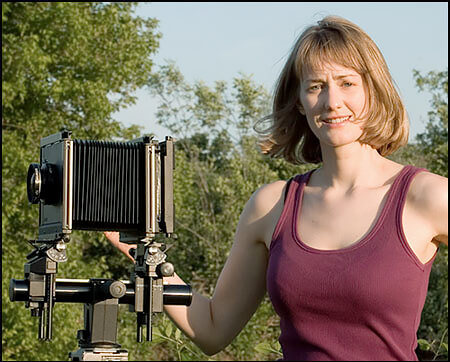Jennifer Little (b. 1977) lives in Oakland, California. Her current photographic work focuses on social and ecological concerns and documents intersections between the natural and the man made.
Jennifer received a B.F.A. in Photography from Washington University in St. Louis and an M.F.A. from the University of Texas at Austin. She is a tenured Associate Professor at University of the Pacific in Stockton, California, where she teaches courses covering Digital Photography, Video Production, Documentary Photography, the History of Photography, and Web Design. Jennifer is Chair of the Art Department at University of the Pacific.
Jennifer Little's new photographic series, 100 Years of Dust: Owens Lake and the Los Angeles Aqueduct, is receiving significant recognition from galleries, publications, and curators. It just won the prestigious 2014 Critical Mass Top 50 Award from PhotoLucida. This series has also been selected for a solo exhibition at University of the Arts' Sol Mednick Gallery in Philadelphia from March 20 - April 24, 2015. Jennifer has been invited to give a presentation about Owens Lake at the Society for Photographic Education (SPE) National Conference in New Orleans, LA, from March 12-15, 2015. She also presented at the SPE West Regional Conference in Los Angeles on November 15, 2014, with Kathy Bancroft, the Tribal Historic Preservation Officer for the Lone Pine Paiute-Shoshone Reservation. Jennifer's series about Owens Lake won the 2014 "Dotphotozine Award for Excellence in Photography" and is featured in the September, 2014, issue of the magazine. This series also won first prize in an October - November, 2013, juried exhibition at Book and Job Gallery on Geary Street in San Francisco: The Human Impact: New Directions in Landscape Photography.
Jennifer has exhibited her work at galleries and museums including Stanford University’s Thomas Welton Stanford Art Gallery; Tag Gallery in Bergamot Station Arts Center, Santa Monica, CA; Photo Center Northwest, Seattle, WA; Kala Art Institute in Berkeley, CA; The San Francisco Arts Commission Gallery; The LAB, San Francisco; Viewpoint Photographic Art Center in Sacramento, CA; Eisentrager-Howard Gallery at The University of Nebraska at Lincoln; The Marin Museum of Contemporary Art in Novato, CA; The Center for Fine Art Photography in Fort Collins, CO; and Jay Etkin Gallery in Memphis, TN.
Jennifer’s work has been published and reviewed in Dotphotozine, View Camera Magazine, ArtAscent Magazine, Camera Arts Magazine, and The Austin Chronicle. Jennifer has presented artist talks at Stanford University, San Francisco Art Institute, the Foto 3 Conference, Kala Art Institute in Berkeley, CA, and the Dimen Cultural Eco-museum Forum on the Preservation and Development of Ancient Villages, Dimen, Guizhou, China.
About Owens Lake and the Los Angeles Aqueduct
This project documents the Los Angeles Department of Water and Power’s (LADWP) legally mandated dust mitigation program at Owens Dry Lake in Southern California. It is the latest chapter in a century of legal battles over water rights and air quality in Owens Valley. Owens Lake lies in Southern California's eastern Sierra, about 200 miles northeast of Los Angeles. This 110-square-mile lake began to dry up in 1913 when the City of Los Angeles diverted the Owens River into the Los Angeles Aqueduct. The new water supply allowed Los Angeles to continue its rapid growth and turned the arid San Fernando Valley into an agricultural oasis, but at a tremendous environmental cost. By 1926, Owens Lake was a dry alkali flat, and its dust became the largest source of carcinogenic particulate air pollution in North America.1
